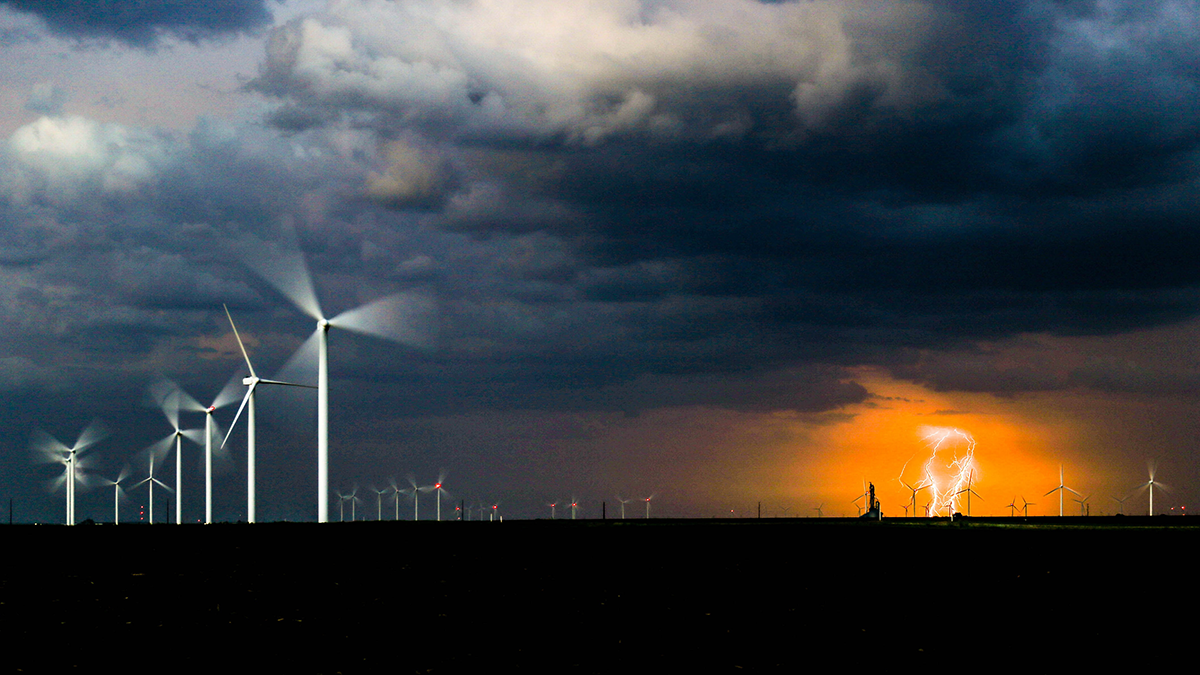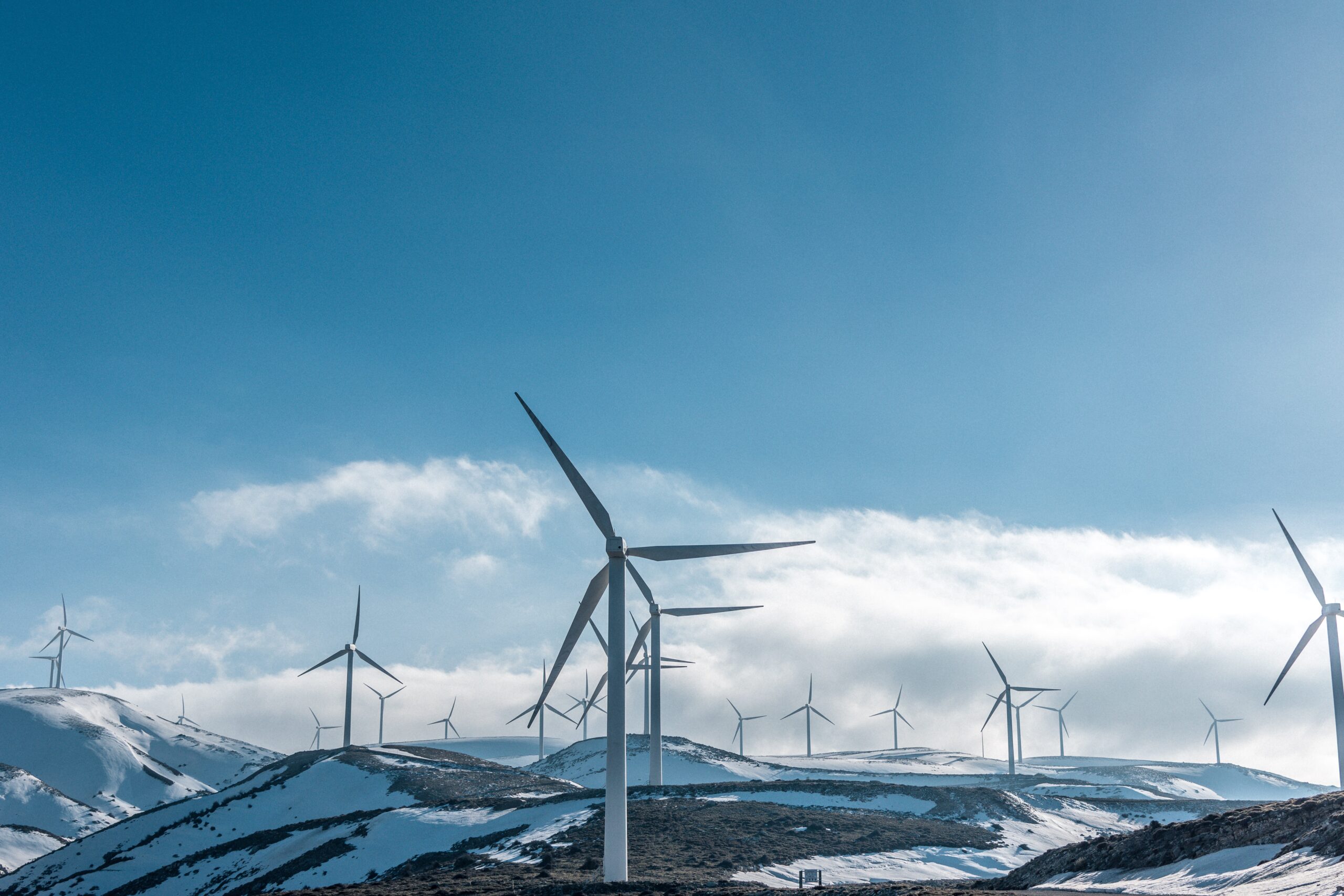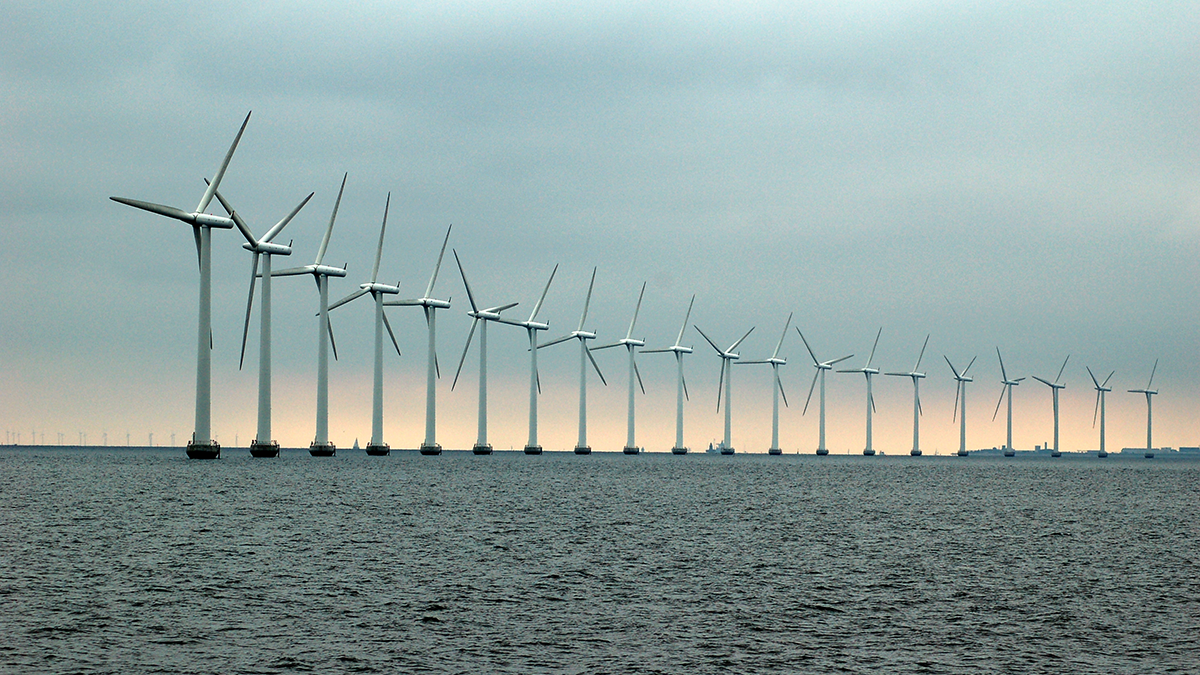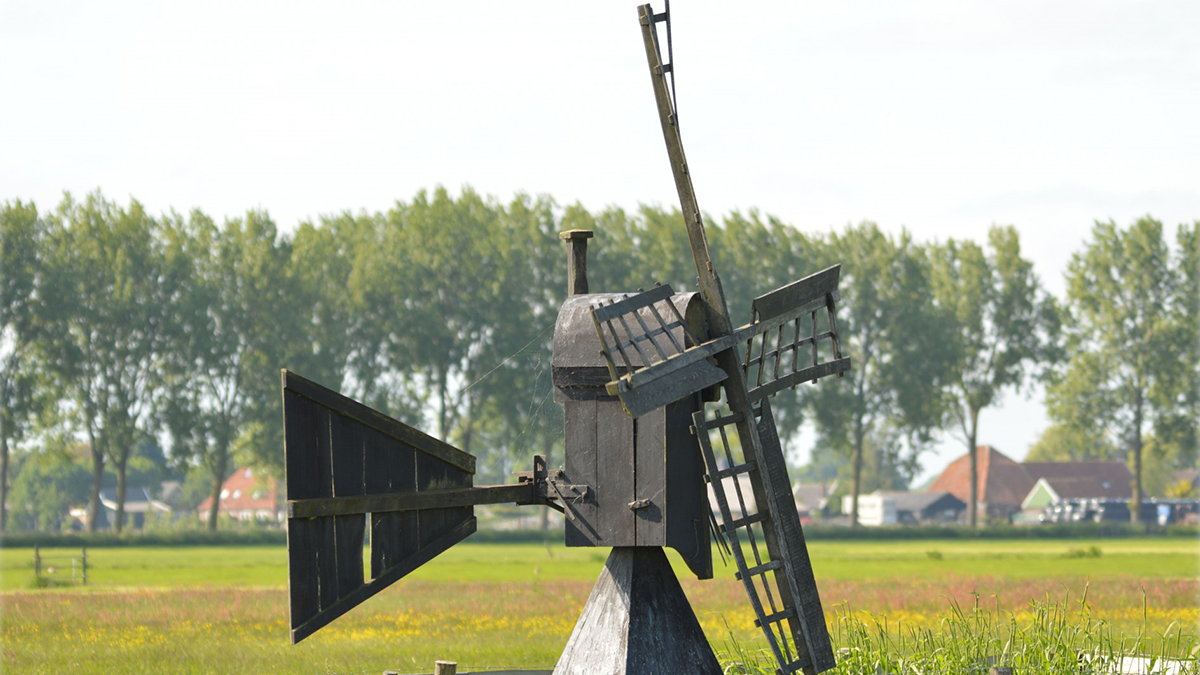We know that there is enough wind globally to satisfy much, or even most, of humanity’s energy requirements – if it could be harvested effectively and on a large enough scale. Vertical axis wind turbines (VAWTs), which may be as efficient as current horizontal axis systems, might be , simpler and significantly cheaper to build and maintain than horizontal axis wind turbines (HAWTs).
They also have other inherent advantages, such as they are always facing the wind, which might make them a significant player in our quest for cheaper, cleaner sources of electricity. VAWTsmight even be critical in mitigating grid interconnect stability and reliability issues currently facing electricity producers and suppliers. Additionally, cheap VAWT’s may provide an alternative to the rain forest destruction for the growing of bio-fuel crops. This paper describes some research findings of a particular original VAWT design and argues for increased research and development of this technology.
Electricity from wind currently supplies less than 0.8% [1] of US and barely 0.9% [2] of world electricity consumption. While it is the fastest growing energy source at an annual rate of some 25% [3] , it will by 2030 [4] still account for only a tiny portion of US and world electricity requirements (less than 3% [5] and less than 4% [6], respectively).
If wind is to become a significantly larger contributor to the production of global electricity, then clearly something different is needed. Perhaps that something is the vertical axis wind turbine. The convergence of rapidly rising costs, dwindling and threatened supply, exploding demand, and growing concern of global climate change is fueling renewed efforts to find viable energy alternatives. Some of the proposed alternatives such as large scale use of bio-fuels may not be achievable or sustainable—or, ultimately, practical. Other exotic possibilities such as geothermal energy may be viable but are local and limited. Solar cell technology is still miniscule, expensive and inefficient. It therefore seems that we are stuck with oil, coal, natural gas (while they last), and wind.
The wind as a fuel for producing electricity is inexhaustible, free and always available somewhere–and there is enough of it. Research shows that “the total amount of electricity that could potentially be generated from wind in the United States has been estimated at 10,777 billion kWh annually—three times the electricity generated in the U.S. today” [7]. Why then are we not harvesting this embarrassment of riches? The answer is, in part, that the modern wind turbine is something produced by hi-tech companies in advanced countries using advanced technologies and as a result are expensive and out of the reach of most poor populations who might have much wind but little money.
What is needed is paradigm shift. Wind turbines need to be viewed as being locally producible devices, made from local materials, and using local skills. This shift could lead to new levels of local energy independence and self-sufficiency for a greater portion of the world’s people—in highly developed and less developed countries alike.
While conventional horizontal axis wind turbines can also be built locally, the skills and materials needed are advanced and sophisticated. Clearly the world is not covered with such windmills at this time. Yet, millions of small windmills in towns, villages and cities across the
planet may be just what we need. The vertical axis turbine may very well be the means to get this done.
Vertical axis wind turbines are inherently simple. The simplest implementations can be made from the split halves of a drum fitted with a small cheap generator. These Savonius Rotors, as they are called, are very good for pumping water and grinding grain, two things that much of the world still does by hand and they can be effective producers of electricity.
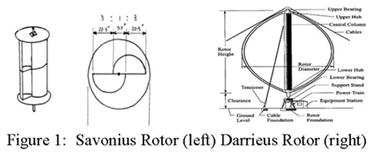
Vertical axis wind turbines (VAWTs) come in two varieties (Fig.1).
Vertical axis wind turbines (VAWTs) in addition to being simpler and cheaper to build have the following advantages:
- They are always facing the wind – no need for steering into the wind.
- Have greater surface area for energy capture – can be many times greater.
- Are more efficient in gusty winds – already facing the gust
- Can be installed in more locations – on roofs, along highways, in parking lots.
- Do not kill birds and wild – life – slow moving and highly visible.
- Can be scaled more easily – from milliwatts tomegawatts.
- Can be significantly less expensive to build – areinherently simpler .
- Can have low maintenance downtime -mechanisms at or near ground level
- Produce less noise – low speed means less noise
- Are more esthetically pleasing – to some.
These inherent advantages make VAWTs a growing field of research and development. There are new and innovative vertical axis wind turbine designs being explored with renewed interest and funding. They are all steps in the right direction, but they are not yet enough.There is a clear need for new thinking and new ideas in the field.
The power contained in a wind stream is given by:
P = 1/2 D A S3 (1)
P = power, D = air density, A = rotor area, S = wind speed
This leads to the two basic laws of wind energy conversion:
1) The power available from the wind varies as the cube of the wind speed;
2) The capacity of the turbine increases with the square of the surface area (swept area) of the turbine
These laws have led us to think that the only way to approach wind energy conversion into electricity is to build the largest turbines possible and place them in the highest wind speed locations. This is not the whole truth. The equation can be read as saying that power is proportional to the volume of air times its density times rotor surface area per unit of time:
P = V*D*A/T (2)
P = power, D = density, V = volume, A = swept area, T = time
This implies that optimization is accomplished by processing the largest volume of air per unit of time over the largest rotor surface area. This is where vertical axis wind turbines may shine.
For a conventional HAWT the volume of air interacting with the turbine per unit of time is a thin disk. Each ‘slice’ of air in this disk contacts the turbine blade momentarily and only once. In the case of a VAWT with the same swept area, that disk becomes a tall cylinder whose height is the height of the rotor. This means that for a given rotor swept area the volume of air contact with the rotor surface can be dramatically larger. In the cylinder of rotation of the VAWT, however, the time of interaction between air and rotor stretches through the length of its diameter, and the angle of interaction varies continuously through the cycle, i.e. there is more and longer contact, more opportunity forenergy extraction.
In the HAWT disk of interaction the volume of interaction per slice of time is small.
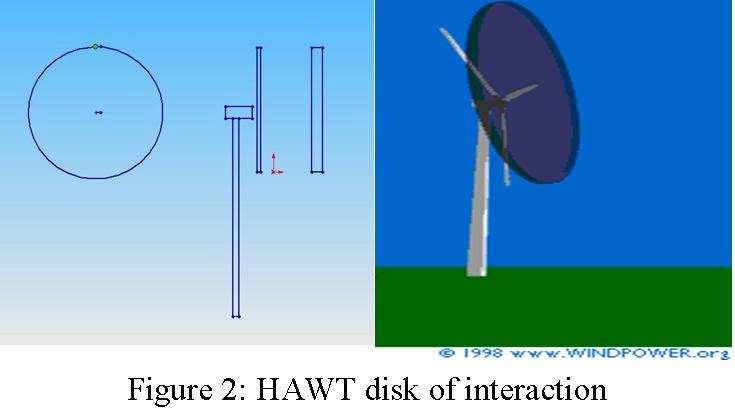
The VAWT’s cylinder of interaction, and the volume of interaction per time slice is much larger.
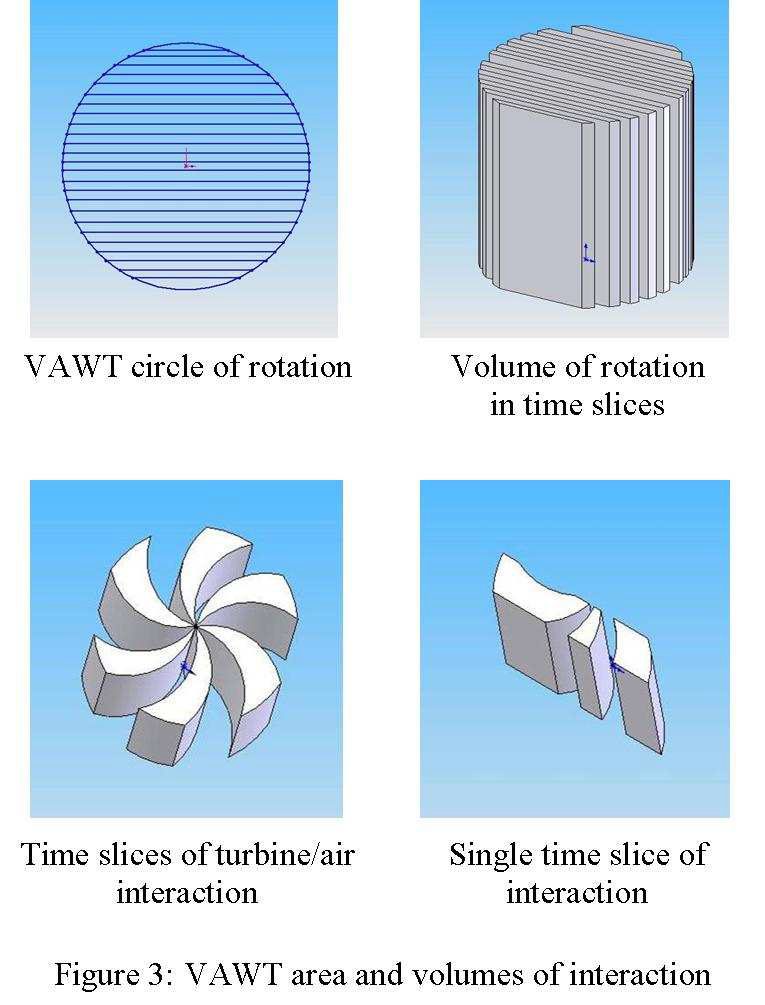
Even if VAWTs were not ultimately more efficient the HAWTs (horizontal turbines)–the wind is, after all, free – they would still merit our interest . What matters is that there are not now enough windmills of all types and sizes available to reap the energy harvest of the wind. The argument being made here is that effective, useful VAWTs can be built by more people, in more places using more athand materials than the conventional horizontal axis variety. Let us build them. As Carl Sagan might say, “millions and millions” of them.
The window of opportunity to defend against global climate change (of the undesirable kind) is estimated by world scientists at some 10 years [8]. This is a very small window and requires that we take maximum action now. Today 49% of the capacity for generating electricity in the United States is
fueled by coal [9]. Even if global climate change were not a fact and a threat, ubiquitous windmills would still be an urgent need.
The burning of fossil fuels is contaminating the air breathe and the foods we consume [10]. Reductions in the production of sulfur-oxides, nitrogen-oxides, and naturally occurring radioactive materials such as uranium and thorium will be additional benefits of more wind energy conversion [11].
Nationwide, as many as 30,000 deaths a year are related to power plant emissions, according to a study by ABT Associates, a private research organization that does work for the EPA.(Washington Post 3/6/02)
In summary, Vertical Axis Wind Turbines may be very beneficial in the quest for clean renewable energy because of:
Cost: Large arrays of VAWTs can be build on much less land, with much less cost, often using locally available materials and skills. This is
increasingly important as an alternative to the cutting down of precious and irreplaceable rain forest to grow crops for ethanol production.
Reliability: It may be possible to install vertical axis turbines into existing conventional wind-farms where grid interconnect bandwidth is available and underutilized. This can capture more of the lower grade winds lost to the larger turbines and improve productivity of the wind-farm as a whole.
Empowerment: Vertical axis systems can be more easily built or cheaply purchased, making personal ownership or small community ownership practical.
Independence: Even very resource poor places may have good winds for energy conversion. Groups of small turbines harvesting these winds
may provide local energy independence and, perhaps, a ladder out of poverty for many.
Availability: Currently windmills are producing only about 25% of the time. 75% of the time they are doing nothing. This means that conventional production must remain on-line to make up the difference–greenhouse gasses and other pollutants not significantly reduced at these production levels.
The advent of powerful software for design, analysis and simulation allows for many types of new ideas to betested virtually. It is hoped that this paper may help to motivate some new thinking and the exploration of new ideas. High school students as well as undergrad and graduate engineering students should be aware of the challenges and opportunities open to them. Let us dream of a world powered by millions of large and small windmills– many vertically oriented, many of designs not yet conceived–thousands of clean, green power stations all
over the world.
Source
The Case for Vertical Axis Wind Turbines Terrence C. Sankar, Robert Morris University, Pittsburgh Pa

